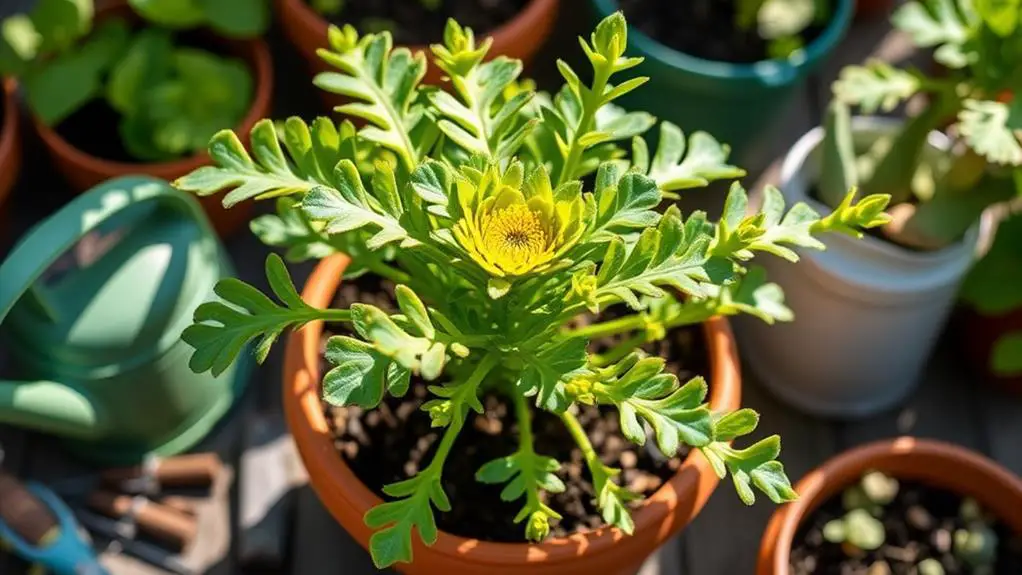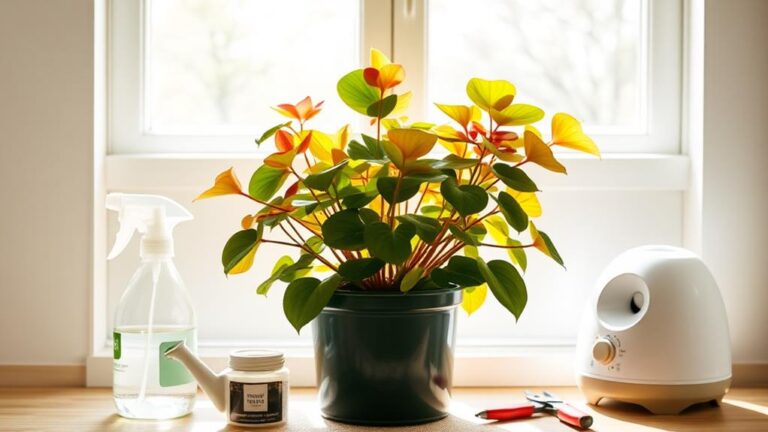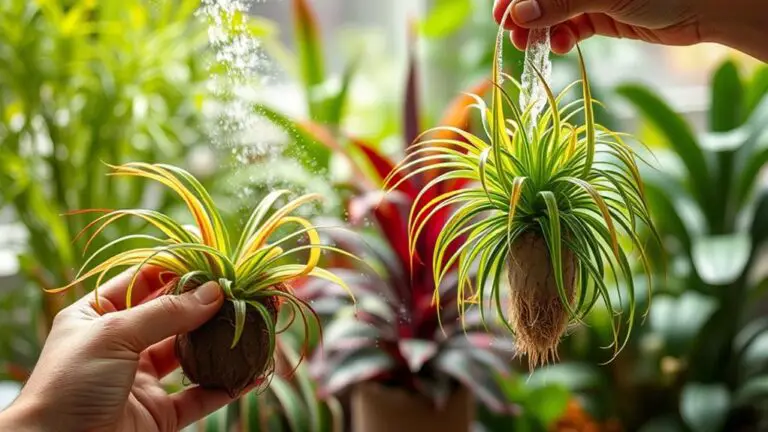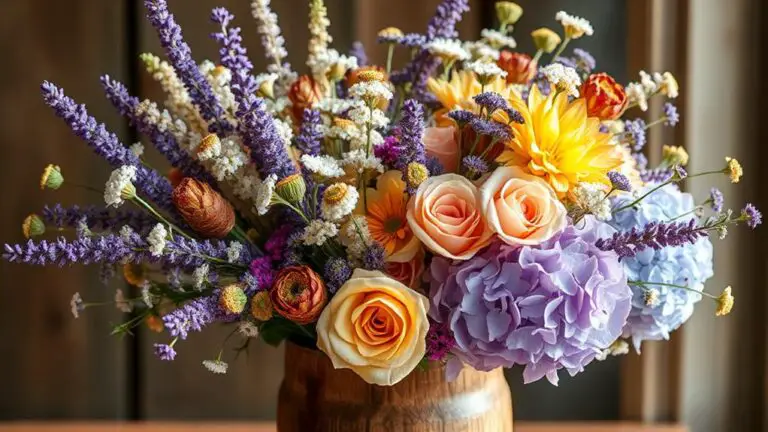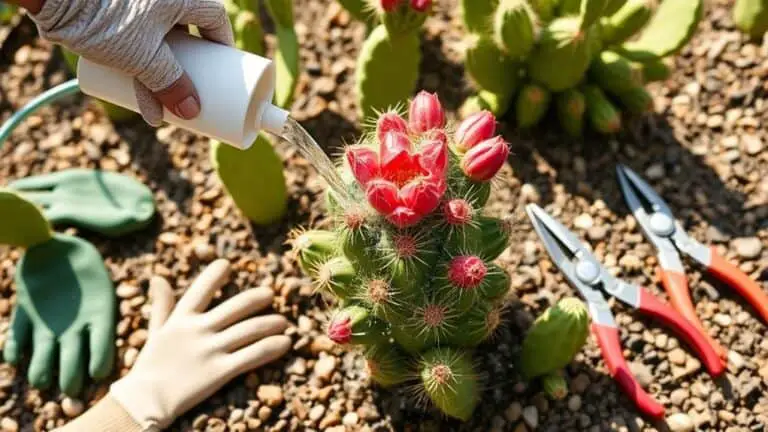10 Essential Steps to Care for Your Pickle Plant (Kleinia Stapeliiformis)
Caring for your Pickle Plant (Kleinia stapeliiformis) might seem straightforward, but there are some specific steps you need to follow to keep it thriving. You'll want to start with providing the right light conditions since this succulent enjoys plenty of bright, direct sunlight. But don't stop there; watering practices are equally important, requiring a thorough yet infrequent approach. How do you balance these needs while ensuring your plant stays healthy? By understanding the full range of care essentials, from soil selection to pest control, you'll master the art of caring for your Pickle Plant. Let's explore the first step in detail.
Light Requirements

The Pickle Plant thrives best when it gets plenty of bright, direct sunlight, ideally within 1 foot of a south-facing window.
To keep your plant healthy, guarantee it receives abundant sunlight. Without enough light, your Pickle Plant might become leggy and lose its vigor.
Keep an eye on regional weather conditions to adjust its light exposure, especially during seasons with shorter days. If natural light isn't enough, consider using grow lights to provide the necessary brightness.
Make sure nothing blocks the sunlight from reaching your plant, as obstructions can hinder its growth.
Watering Practices
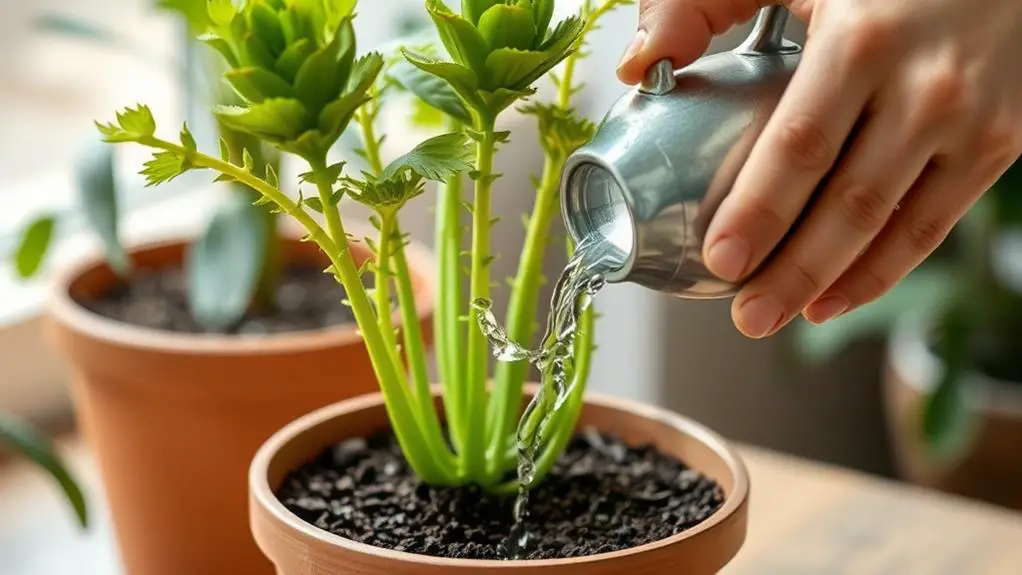
When it comes to watering your Pickle Plant, it's important to water thoroughly but not too often.
Give it about 0.5 cups every 9 days, making sure the top inch of soil dries out between waterings to prevent root rot.
Be sure to adjust your schedule during winter since the plant needs less water when it's dormant.
Optimal Watering Frequency
Guaranteeing your Pickle Plant thrives hinges on mastering its ideal watering frequency. Water it thoroughly but infrequently, giving about 0.5 cups every 9 days. Always let the top inch of soil dry out first. This helps maintain peak soil moisture and prevents root rot.
Overwatering can cause yellowing or drooping leaves, so adjust based on temperature and humidity. During the dormancy period in winter, reduce watering frequency since the plant needs less water in cooler conditions.
Monitor the soil moisture regularly because the Pickle Plant prefers soil that dries out between waterings. You'll need to water more often during the active growth period in warmer months.
Following these tips guarantees your Pickle Plant stays healthy and vibrant.
Preventing Root Rot
Root rot is a common issue for Pickle Plants, but you can prevent it with proper watering practices.
First, always water lightly and make sure your pot has drainage holes. This helps excess water escape and avoids overwatering, which leads to root rot.
Allow the top inch of soil to dry out completely before you water again, typically every 9 days. Use a well-draining soil mix designed for succulents and cacti to guarantee good air circulation around the roots.
If you notice yellowing or drooping leaves, it might be a sign of root rot, indicating too much moisture.
Seasonal Water Adjustments**
Preventing root rot is just one part of keeping your Pickle Plant healthy; another key aspect is adjusting your watering practices based on the season.
During spring and summer, water thoroughly every 9 days, letting the top inch of soil dry out. As winter approaches, reduce watering to every 14-21 days, since the plant enters dormancy.
Always check the soil moisture level before watering by feeling the top inch of soil. Environmental conditions like temperature and humidity also play a role; warmer and drier conditions mean more frequent watering.
If leaves shrivel, it might need more water. Yellow leaves can signal overwatering.
Adjusting your watering schedule with these seasonal water adjustments will keep your Pickle Plant thriving all year long.
Fertilization Needs
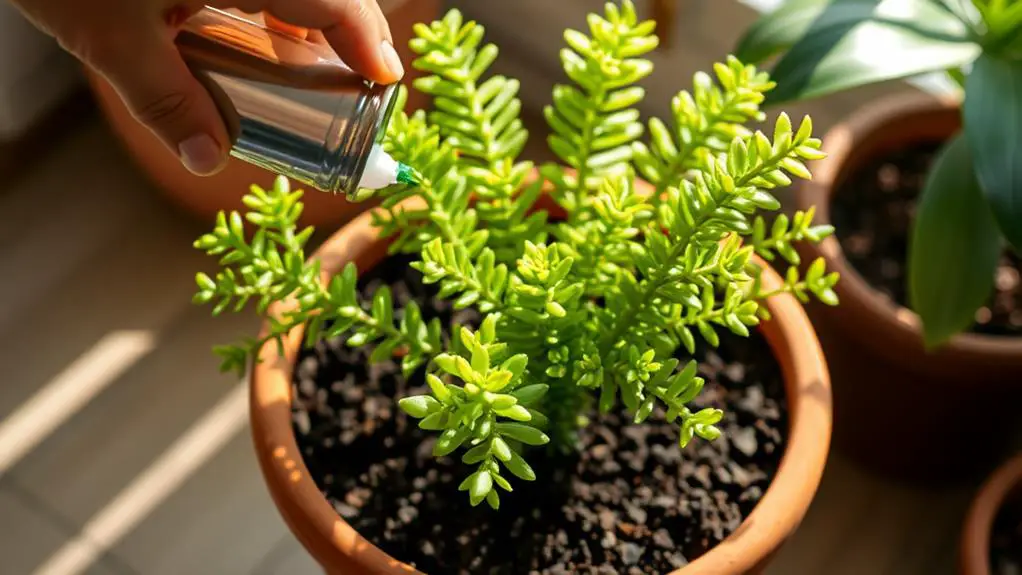
Fertilizing your Pickle Plant (Kleinia stapeliiformis) is essential for its health and growth.
You'll want to use a balanced fertilizer during the active growth periods, typically in spring and summer. This promotes healthy growth and blooming.
Watch for signs of nutrient depletion, like slow growth or discoloration, to know if more fertilization is needed. Usually, potting soil has enough nutrients initially, but consider repotting annually or when the plant doubles in size.
To avoid over-fertilization, dilute the fertilizer to half the recommended strength. Apply it every 4-6 weeks during the growing season.
Soil and Potting

To keep your Pickle Plant happy, start with a well-draining soil mix made for cacti and succulents, which helps prevent waterlogging.
Make sure to use pots with drainage holes so excess water can escape, reducing the risk of root rot.
Repot your plant every 2-3 years or when the roots start peeking through the drainage holes, choosing slightly larger pots made from materials like terra cotta or ceramic to enhance drainage.
Choosing Potting Mix
Choosing the right potting mix for your Pickle Plant is essential for its health and longevity. Use a well-draining, gritty-textured potting mix designed for cacti and succulents to prevent root rot and guarantee proper drainage.
Avoid heavy soils that retain excess moisture, as your Pickle Plant prefers soil that dries out between waterings. Repotting isn't needed often; every 2-3 years is usually enough, or when roots appear through drainage holes.
Here are some key tips:
- Use a specialized potting mix: Opt for one meant for cacti and succulents.
- Monitor soil condition: Check regularly and avoid waterlogged conditions.
- Repot when necessary: Refresh soil and nutrients every few years.
This careful attention will keep your Pickle Plant thriving!
Proper Drainage Techniques
Ensuring proper drainage is essential for the health of your Pickle Plant. First, always use a well-draining soil mix specifically designed for cacti and succulents. This prevents mistakes like waterlogged roots.
Choose pots with drainage holes to let excess water escape, avoiding root rot. Opt for slightly larger pots than the current root ball, using porous materials like terra cotta or ceramic for better aeration.
Regularly check the potting mix, ensuring it dries between watering sessions to prevent fungal issues.
Don't forget, repotting every 2-3 years or when roots show through the drainage holes helps refresh the soil and promotes healthy growth.
Repotting Frequency Tips**
Repotting your Pickle Plant is essential for its continued health and growth. Every 2-3 years, or when you see roots growing through the drainage holes, it's time to repot.
Choose a well-draining, gritty-textured soil mix designed for cacti and succulents. This promotes ideal growth and prevents root rot. Select a pot slightly larger than the current root ball and guarantee it has drainage holes to avoid excess moisture.
During repotting, inspect the roots for rot or damage, trimming any unhealthy sections before planting in fresh soil.
- Use a gritty-textured soil mix for cacti and succulents.
- Check for roots growing through drainage holes.
- Select a pot with adequate drainage holes.
Temperature and Humidity
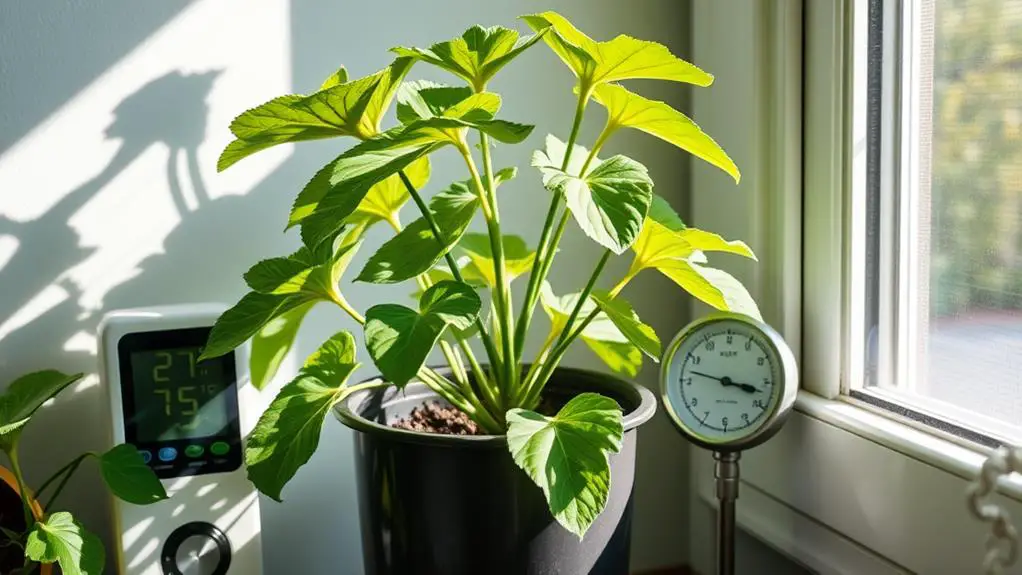
A crucial aspect of caring for a Pickle Plant (Kleinia stapeliiformis) is maintaining the right temperature and humidity. Aim for temperatures between 65°F to 80°F (18°C to 27°C) for ideal growth. Protect your plant from frost; temperatures below 50°F can damage it. While the Pickle Plant tolerates summer heat up to 90°F, guarantee good air circulation to prevent overheating. This plant prefers low humidity, as too much moisture can lead to rot. Proper air circulation is necessary to avoid fungal diseases.
| Temperature Range | Ideal Conditions | Key Tips |
|---|---|---|
| 65°F to 80°F | Ideal growth | Maintain airflow |
| Below 50°F | Damage risk | Avoid frost |
| Up to 90°F | Tolerable if airflow | Guarantee ventilation |
| High Humidity | Risk of rot | Prefer low humidity |
With these guidelines, your Pickle Plant will thrive!
Pruning Tips
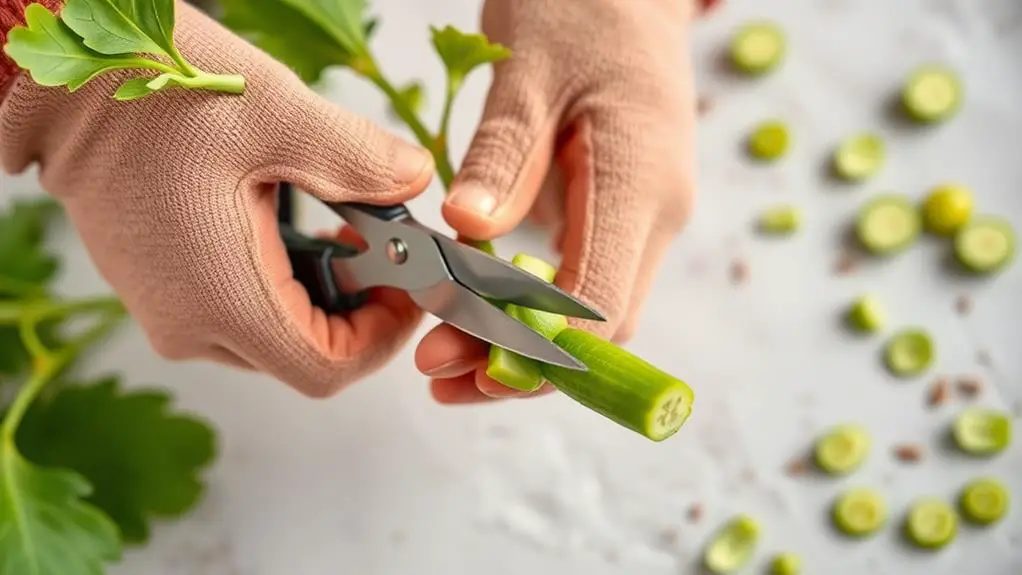
When it's time to prune your Pickle Plant, aim for spring or early summer when the plant is actively growing.
Use clean, sharp tools to remove any dead or damaged stems and encourage new growth.
Regular inspections and occasional pruning will keep your plant healthy and looking its best.
When to Prune
To keep your Pickle Plant (Kleinia stapeliiformis) healthy and visually appealing, prune it in the spring or early summer when it's actively growing. Regular pruning helps maintain its shape and encourages healthy growth.
Focus on removing any dead stems, damaged, or yellowing parts to prevent disease. Pruning tools should be clean and sharp to avoid infections and guarantee clean cuts.
While this plant doesn't need frequent pruning due to its compact growth, occasional shaping can enhance its look.
Here are some key tips to remember:
- Remove dead stems regularly to keep the plant healthy.
- Use clean, sharp pruning tools to prevent infections.
- Monitor for signs of distress, like leggy growth, and prune accordingly.
Tools for Pruning
After understanding the best times and reasons for pruning your Pickle Plant, it's important to know which tools will help you achieve clean, healthy cuts. Always use clean, sharp pruning shears to avoid spreading disease. This is essential for maintaining plant health.
Prune during spring or early summer to encourage healthy regrowth. Regularly inspect your plant for yellowing or unhealthy leaves and remove them promptly. Though the Pickle Plant doesn't need frequent pruning due to its compact growth, occasional maintenance helps keep it looking its best.
Be certain your cuts are at a slight angle to allow water runoff and reduce the risk of rot. Proper tools and techniques guarantee your plant stays healthy and vibrant.
Pruning Benefits**
Pruning your Pickle Plant offers numerous benefits that contribute to its overall health and appearance. Regular pruning helps maintain a compact growth habit, making your plant look neat and preventing overcrowding.
By removing damaged or dead stems during the active growth period in spring or early summer, you promote new growth and guarantee your plant stays strong.
- Encourages new growth: Pruning stimulates the development of fresh stems and leaves.
- Improves overall health: Removing unhealthy parts allows the plant to focus its energy where it's needed.
- Enhances visual appeal: Pruning helps your Pickle Plant maintain a tidy, attractive shape.
Always use clean, sharp tools to minimize disease risk.
Keep an eye out for signs of distress, like yellowing leaves, to know when pruning is necessary.
Propagation Methods
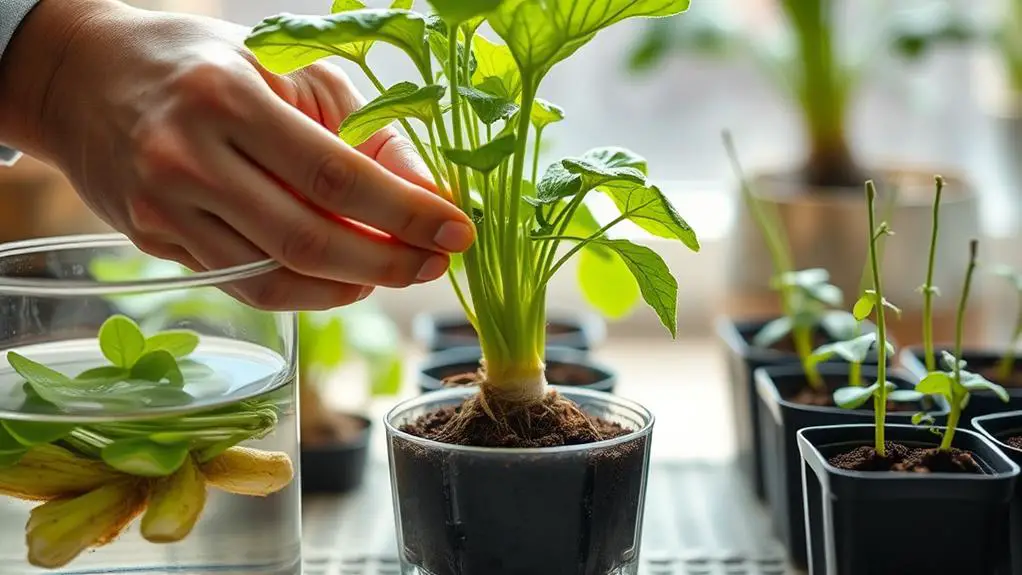
Propagating the Pickle Plant, also known as Kleinia stapeliiformis, can be a straightforward and rewarding process.
There are two main propagation methods you can use: stem cuttings and offsets. For stem cuttings, choose healthy stems in spring or early summer, let them callus for a few days, then plant them in well-draining soil.
Offsets, the small plantlets that grow underground, can be carefully removed and potted separately. Both methods require providing bright, indirect light to help the new plants root and grow.
Roots usually develop within a few weeks to a couple of months if you've created ideal conditions. Propagation during the growing season, especially in warmer months, increases your chances of success.
Pest Control
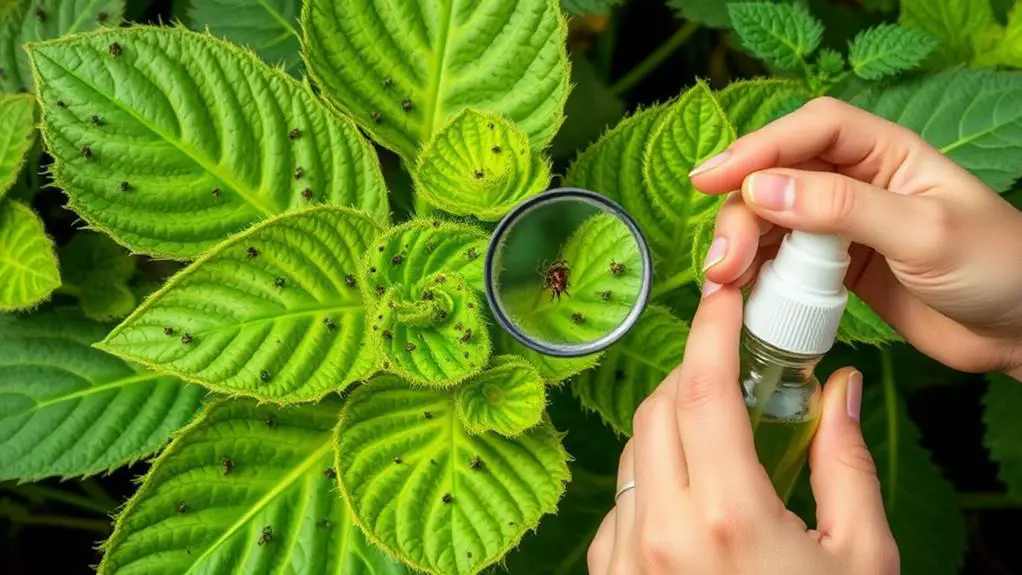
Ensuring your Pickle Plant remains healthy doesn't stop at propagation; keeping pests at bay is equally important. Regularly inspect your plant for pest infestations like mealybugs and aphids. These pests can cause serious damage if ignored. Use insecticidal soap or neem oil as preventive measures, following the manufacturer's instructions to protect your plant.
- Maintain good air circulation to reduce humidity, which helps deter pests and prevents fungal infections.
- Monitor soil moisture to avoid overwatering, which can attract pests like fungus gnats.
- If you spot pests, isolate the infested plant and treat it promptly.
Identifying Problems
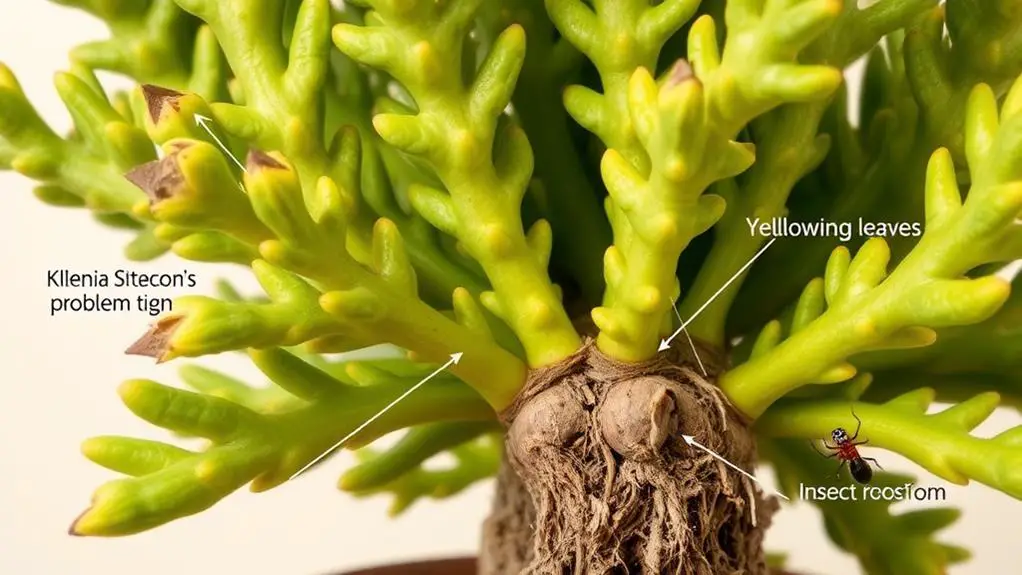
How can you tell if your pickle plant is in distress? Watch for yellowing leaves, a common sign of overwatering. Check the soil moisture and let the top inch dry before watering again. Wilting or shriveled leaves likely mean underwatering, so give your plant a good drink. Leaf drop can indicate stress from temperature changes or poor lighting. Regularly inspect your plant for pests like mealybugs and aphids, which can cause serious damage. Also, be mindful of fungal infections from poor air circulation and overwatering. Guarantee proper drainage and ventilation to avoid these issues.
| Problem | Cause | Solution |
|---|---|---|
| Yellowing Leaves | Overwatering | Let top inch of soil dry out |
| Wilting Leaves | Underwatering | Water the plant thoroughly |
| Leaf Drop | Environmental Stress | Adjust light/temperature conditions |
| Pests | Mealybugs, Aphids | Inspect and treat promptly |
| Fungal Infections | Poor Air Circulation | Improve drainage and airflow |
Safety and Toxicity

While keeping an eye out for any issues, it's also important to take into account the safety and toxicity of your Kleinia stapeliiformis, or Pickle Plant.
Generally, this plant is non-toxic to humans and pets. However, it's wise to keep it out of reach of children and pets to avoid any potential allergic reactions or ingestion. If ingested, it might cause mild stomach upset.
Here are some safety tips:
- Monitor for allergic reactions: Watch out for any signs of skin irritation or discomfort.
- Keep out of reach: Place the plant where curious kids and playful pets can't get to it.
- Know emergency contacts: Have Poison Control (800-222-1222) and ASPCA (888-426-4435) numbers handy just in case.
Taking these steps guarantees a safe environment for everyone.
Frequently Asked Questions
How to Care for Kleinia Stapeliiformis?
Place your Pickle Plant in bright, direct sunlight, water thoroughly every 9 days, and use well-draining soil. Fertilize during the growing season and check for pests regularly. This keeps your Kleinia stapeliiformis healthy and thriving.
How Do I Care for My Pickle Plant?
Place your Pickle Plant near a south-facing window for bright light. Water it with 0.5 cups every 9 days, letting the soil dry first. Use well-draining soil, fertilize during growth, and check for pests regularly.
How Do You Care for Senecio Kleinia?
You care for Senecio Kleinia by placing it in bright, direct sunlight, watering infrequently, using well-draining soil, and fertilizing during growth periods. Regularly check for pests and treat promptly to keep your plant healthy.
Do Pickle Plants Like Direct Sun?
Yes, pickle plants love direct sun. Place them within 1ft of a south-facing window for ideal light. Monitor for sunburn in extreme heat. If natural light's limited, use grow lights to guarantee they're getting enough.
Conclusion
Taking care of your Pickle Plant doesn't have to be hard. Just follow these steps: give it bright light, water it properly, and use well-draining soil. Don't forget to fertilize, prune, and watch out for pests. Keep the temperature just right, and your plant will thrive. If you see any problems, address them quickly. With a little attention, your Pickle Plant will grow beautifully, and you'll feel like a confident gardener in no time!

